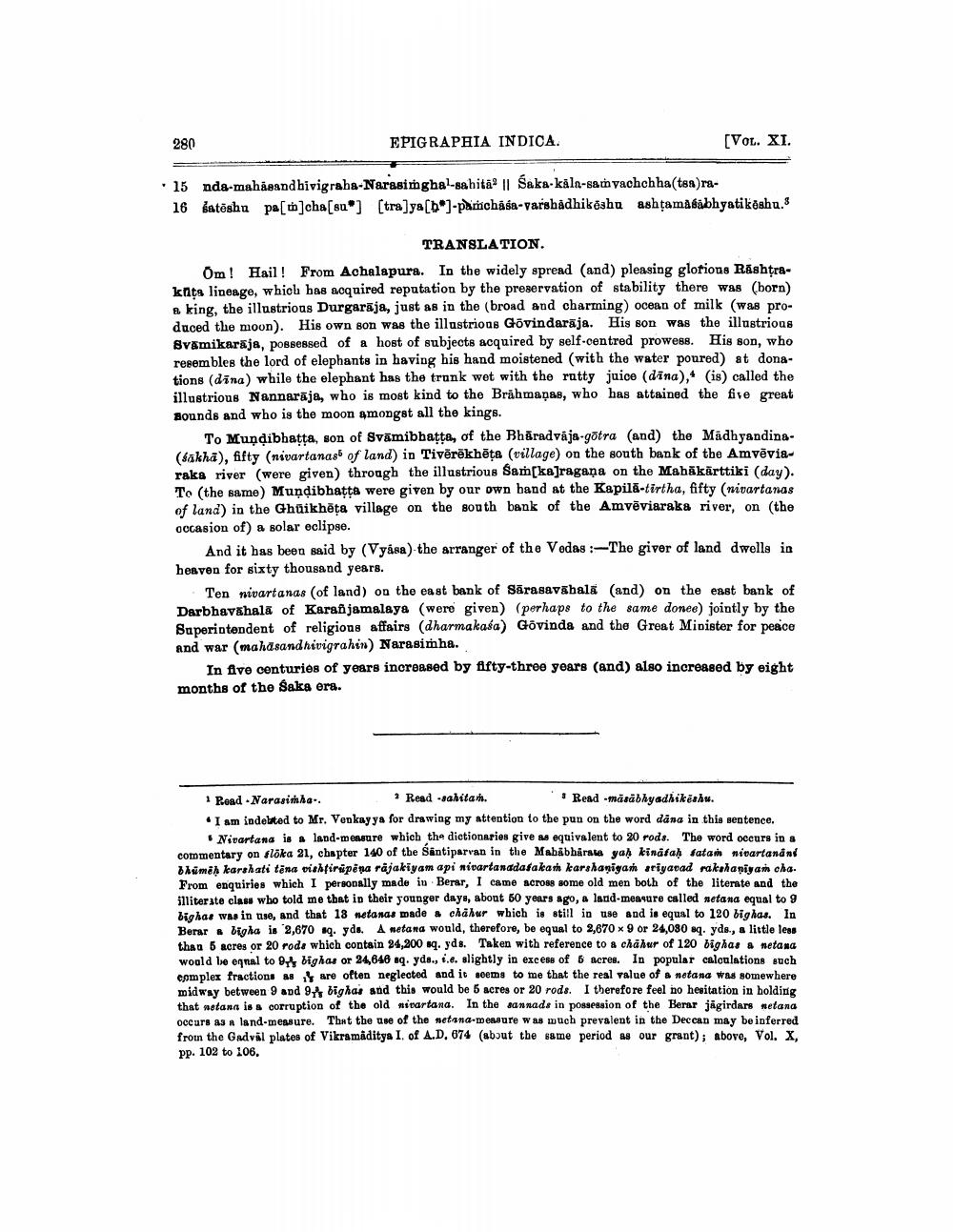________________
280
EPIGRAPHIA INDICA.
[Vol. XI.
. 15 nda-mahaeand hivigraha-Narasimgha-sahita || Saka-käln-samvachchha(tea)ra
16 satosha pa[m]cha[su"] [tra]ya[bo]-panchasa-varshadhikesho ashtamasabhyatikoahu.
TRANSLATION. Om! Hail! From Achalapura. In the widely spread (and) pleasing glorious Rashtrakita lineage, which has acquired reputation by the preservation of stability there was (born) aking, the illustrious Durgarāja, just as in the (broad and charming) ocean of milk (was produced the moon). His own son was the illustrious Govindarāja. His son was the illustrious Svāmikaraja, possessed of a host of subjects acquired by self-centred prowess. His son, who resembles the lord of elephants in having his hand moistened (with the water poured) at donations (dina) while the elephant has the trunk wet with the ratty juice (dana), (is) called the illustrious Nannaraja, who is most kind to the Brāhmaṇas, who has attained the five great Sounds and who is the moon amongst all the kings.
To Mundibbatta, son of Svāmibbatta, of the Bhāradvájs-gotra (and) the Madhyandina(Sakha), fifty (nivartanast of land) in Tivērēkbēta (village) on the south bank of the Amvëviaraka river (were given) through the illustrious Sam[ka]ragana on the Mabäkärttiki (day). To the same) Mundibhatta were given by our own band at the Kapild-tirtha, fifty (wivartanas of land) in the Ghoikhëța village on the south bank of the Amvëviaraka river, on (the occasion of) a solar eclipse.
And it has been said by (Vyåsa) the arranger of the Vedas :-The giver of land dwells in heaven for sixty thousand years.
Ten nivartanas (of land) on the east bank of Sārasaväbalá (and) on the east bank of Darbhav hala of Karanjamalaya (were given) (perhaps to the same donee) jointly by the Superintendent of religions affairs (dharmakasa) Govinda and the Great Minister for peace and war (mahasandhivigrahin) Narasimha.
In five centuries of years increased by fifty-three years (and) also increased by eight months of the Saka era.
Read - Narasimha.. * Read -sakitan.
Read masabhyadhikaks. • I am indebted to Mr. Venkayya for drawing my attention to the puu on the word dana in this sentence.
• Nivartana island-messure which the dictionaries give equivalent to 20 rods. The word occurs in a commentary on flöka 21, chapter 140 of the Santiparvan in the Mahabharata ya kinafah fatan Winartando Bhamë) karshati tēna vahtiripena rajakiyam api nivartanadafakar karshanigan eriyavad nakahaniyan cha. From enquiries which I personally made in Berar, I came across some old men both of the literate and the illiterate class who told me that in their younger day, about 50 years ago, a land measure called stand equal to 9 bighae was in use, and that 18 nelands made chahut which is still in use and is equal to 120 biglas. In Berar • bigha is 3,670 sq. yde. Anetand would, therefore, be equal to 2,670 x 9 or 24,080 sq yds, a little less thaa 5 acres or 20 roda which contain 34,200 sq. yds. Taken with reference to a chahur of 120 bighas a metana would be eqnal to Di Mighas or 24,648 sq. yde., 6.6. slightly in excess of 6 acres. In popular caloulations such complex fractions as are often neglected and it seems to me that the real value of notana was somewhere midway between 9 and 9 bighas and this would be 5 acres or 20 rods. I therefore feel no hesitation in holding that notana is a corruption of the old mirarland. In the annade in possession of the Berar jagirdars welana occurs as a land measure. That the use of the netand measure was much prevalent in the Deccan may be inferred from the Godval plates of Vikramaditya I of A.D. 674 (about the same period our grant); above, Vol. X, Pp. 102 to 106.




